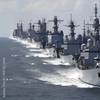A plaque placed on the aft capstan of the wreckage in the Gulf of Thailand believed to be that of World War II submarine USS Lagarto (SS 371) is seen in this screen grab of video. U.S. Navy photo by Senior Chief Navy Diver Michael Moser
Experts at the Naval Historical Center in Washington, D.C., have confirmed that a World War II submarine wreck found in the Gulf of Thailand last year is USS Lagarto (SS 371).
Underwater archeologists at the center completed their examination of evidence obtained in June by Navy divers from USS Salvor (ARS 52) and Mobile Diving and Salvage Unit 1, both based in Pearl Harbor.
"We now know for certain that this is Lagarto," said Rear Adm. Jeffrey Cassias, commander of the U.S. Pacific Fleet submarine force. "I am grateful to all those involved in helping to bring closure to the families of these 86 men who died in service to our nation."
For 60 years, crew members' families did not know the exact circumstances surrounding the 86 submariners who perished. Lagarto was last heard from May 3, 1945, as she was preparing to attack a Japanese convoy under heavy escorts in the Gulf of Thailand. Japanese war records later revealed that the minelayer Hatsutaka reported sinking a U.S. submarine at roughly the same time and location.
In May 2005, British wreck diver Jamie MacLeod reported finding the sunken Lagarto lying upright in about 225 feet of water. Though the documentation provided by MacLeod was compelling, Navy officials waited to see the wreckage for themselves before stating for certain that the wreck was Lagarto. The Thailand phase of exercise Cooperation Afloat Readiness and Training (CARAT) provided an opportunity for Navy divers to visit the site in June.
"During the initial planning conferences, we realized we would have a salvage ship very close to this site," said Cmdr. Tony San Jose, U.S. 7th Fleet's diving and salvage officer. "So by incorporating this into CARAT, we would be able to bring closure to the families and at the same time accomplish some training objectives."
In preparation for that expedition, experts at the Naval Historical Center collected and reviewed all of their records about Lagarto, as well as their extensive holdings on Balao-class submarines. The center's team of historians and underwater archeologists obtained copies of the original plans and photos of Lagarto from the National Archives, consulted with the Wisconsin Maritime Museum in Manitowoc, Wis., where Lagarto was built, and traveled to Baltimore to inspect Lagarto's sister ship USS Torsk (SS 493), which is now used as a museum.
Because the extreme depth would limit bottom time, the archaeologists and historians prepared an extensive background package to direct the divers towards the physical features most likely to give clues to its identity. They recommended that the divers focus their efforts on several key features, including:
- The number of deck guns. Lagarto was one of only three World War II-era submarines known to have been fitted with two 5-inch deck guns, one forward and one aft.
- The location of the anchor. Depending on the manufacturer, Balao-class submarine anchors were fitted to either the port or starboard side. Submarines built in Manitowoc, like Lagarto, had theirs on the starboard side.
- Markings on the propeller. Naval Historical Center researchers examining the propeller of USS Pompon (SS 267) in Alexandria, Va., found Pompon's name was stamped on the hub.
- Markings on the forward capstan or torpedo-loading hatches. The inspection of Torsk revealed that its name was stamped in these places.
USS Salvor (ARS 52) and USS Patriot (MCM 7) arrived on station June 10. Using coordinates provided by MacLeod, the Japan-based Patriot first pinpointed the location of the wreckage with its SQQ-32 sonar and remotely-operated Mine Neutralization Vehicle. After conducting a precision anchorage directly above the wreck, divers from Salvor and Mobile Diving and Salvage Unit 1, both based in Pearl Harbor, spent the next six days carrying out a series of dives utilizing mixed gas of helium and oxygen.
The depths limited divers to just 20 minutes of bottom time per dive, with two divers per dive. When each dive was completed, the divers had to spend one hour slowly ascending to the surface, followed by two more hours in a decompression chamber. Given these challenges, dives were limited to three per day, or 16 total over the six days.
"There's so much time invested in each dive because of the amount of decompression that is required to bring someone back up from that depth," said Chief Navy Diver Matthew Stevens of Salvor. "The main thing is getting down to the bottom, making sure I can clear, making sure that I'm doing what I need to do."
The divers remained in daily contact with the Naval Historical Center while they were on station, updating the Navy's underwater archaeologists on their findings. Divers were quickly able to confirm the location of the wreck, the fact that it was a Balao-class submarine, the existence of two 5-inch deck guns, and the starboard location of its anchor. All of these factors indicated that it was Lagarto.
On the final dive, divers left a brass plaque on the capstan of the sub honoring the 86 Sailors believed entombed inside. Back on the surface, Salvor's crew held a memorial ceremony on deck. Crew members also took the time to read letters from family members and reflect on the tragedy that had befallen Lagarto's crew.
"We all kind of talked about what actually happened and what could have happened," said Gunner's Mate 2nd Class Byran Zenoni, a diver on Salvor. "To actually read what the families are saying and how much it really means...it kind of gives you that extra push to really get the job done."
During their six days on station, the Navy divers took about 10 hours of video and 500 digital photographs, which were sent to the Naval Historical Center for analysis. Once there, experts began the long process of examining and evaluating all of the material.
In addition to the twin 5-inch gun configuration and starboard anchor, researchers focused on a spot on the propeller where they had seen Pompon's name engraved during their inspection of that submarine. Divers were able to scrape away marine growth to show the letters "LA," which was probably part of Lagarto's name. They also saw the word "Manitowoc" engraved on the propeller. Lagarto was one of 28 submarines built in Manitowoc, Wis., of which four were lost during the war. None of the other three ill-fated Manitowoc submarines - USS Robalo (SS 273), USS Kete (SS 369) and USS Golet (SS 361) - was operating near the Gulf of Thailand when they were lost.
As part of their research of Lagarto, Naval Historical Center researchers had interviewed retired Capt. Robert Gillette of the Undersea Museum Foundation. Gillette, who was a submarine commander during World War II, agreed it was Lagarto.
"Manitowoc built a limited number of subs, which increases the probability that this sub is Lagarto," said Gillette. "It was common practice to put the name of the sub on critical parts, especially the propeller. There is no question in my mind that this wreckage is Lagarto."
Retired Rear Adm. Paul Tobin, director of the Naval Historical Center, lauded the work of the divers and his staff of historians and archaeologists who helped to confirm the discovery.
“All of the hard work by Pacific Fleet and Naval Historical Center personnel has helped bring some closure to the families of the 86 men lost aboard Lagarto, and has shed new light on one of the many mysteries of World War II," said Tobin.
Lagarto was one of 52 submarines lost on patrol during World War II. Cassias, who commands the Pacific submarine force, said that the legacy of the men who served on submarines continues to inspire submariners today.
“We owe a great debt to these men, and to all of the World War II submariners,” said Cassias. “In the world's darkest hour, they faced the greatest risks and demonstrated the most noble courage to preserve the freedom of our nation.”
Source: NavNews
From Commander, Submarine Force, U.S. Pacific Fleet and Naval Historical Center Public Affairs
Sponsored Content
Innovative Hull Maintenance: Profitable & Green

Subscribe for
Maritime Reporter E-News
Maritime Reporter E-News is the maritime industry's largest circulation and most authoritative ENews Service, delivered to your Email five times per week












